 W
WAstronomical coordinate systems are organized arrangements for specifying positions of satellites, planets, stars, galaxies, and other celestial objects relative to physical reference points available to a situated observer. Coordinate systems in astronomy can specify an object's position in three-dimensional space or plot merely its direction on a celestial sphere, if the object's distance is unknown or trivial.
 W
WAn almucantar is a circle on the celestial sphere parallel to the horizon. Two stars that lie on the same almucantar have the same altitude.
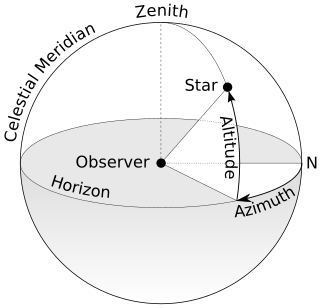 W
WAn azimuth is an angular measurement in a spherical coordinate system. The vector from an observer (origin) to a point of interest is projected perpendicularly onto a reference plane; the angle between the projected vector and a reference vector on the reference plane is called the azimuth.
 W
WIn astronomy, the barycenter is the center of mass of two or more bodies that orbit one another and is the point about which the bodies orbit. It is an important concept in fields such as astronomy and astrophysics. The distance from a body's center of mass to the barycenter can be calculated as a two-body problem.
 W
WA circumpolar star is a star, as viewed from a given latitude on Earth, that never sets below the horizon due to its apparent proximity to one of the celestial poles. Circumpolar stars are therefore visible from said location toward the nearest pole for the entire night on every night of the year.
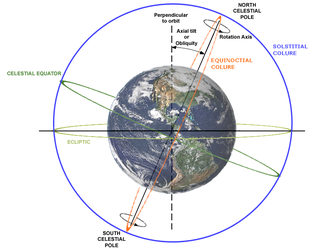 W
WColure, in astronomy, is either of the two principal meridians of the celestial sphere.
 W
WIn astronomy, declination is one of the two angles that locate a point on the celestial sphere in the equatorial coordinate system, the other being hour angle. Declination's angle is measured north or south of the celestial equator, along the hour circle passing through the point in question.
 W
WEarth-centered inertial (ECI) coordinate frames have their origins at the center of mass of Earth and are fixed with respect to the stars. "I" in "ECI" stands for inertial, in contrast to the "Earth-centered - Earth-fixed" (ECEF) frames, which remains fixed with respect to Earth's surface in its rotation, and then rotates with respect to stars.
 W
WThe ecliptic is the plane of Earth's orbit around the Sun. From the perspective of an observer on Earth, the Sun's movement around the celestial sphere over the course of a year traces out a path along the ecliptic against the background of stars. The ecliptic is an important reference plane and is the basis of the ecliptic coordinate system.
 W
WThe ecliptic coordinate system is a celestial coordinate system commonly used for representing the apparent positions, orbits, and pole orientations of Solar System objects. Because most planets and many small Solar System bodies have orbits with only slight inclinations to the ecliptic, using it as the fundamental plane is convenient. The system's origin can be the center of either the Sun or Earth, its primary direction is towards the vernal (March) equinox, and it has a right-hand convention. It may be implemented in spherical or rectangular coordinates.
 W
WThe Earth's equator is an imaginary planetary line that is about 40,075 km (24,901 mi) long in circumference. The equator divides the planet into the Northern Hemisphere and Southern Hemisphere and is located at 0 degrees latitude, the halfway line between the North Pole and South Pole.
 W
WThe celestial equator is the great circle of the imaginary celestial sphere on the same plane as the equator of Earth. This plane of reference bases the equatorial coordinate system. In other words, the celestial equator is an abstract projection of the terrestrial equator into outer space. Due to Earth's axial tilt, the celestial equator is currently inclined by about 23.44° with respect to the ecliptic, but has varied from about 22.0° to 24.5° over the past 5 million years due to perturbation from other planets.
 W
WThe equatorial coordinate system is a celestial coordinate system widely used to specify the positions of celestial objects. It may be implemented in spherical or rectangular coordinates, both defined by an origin at the centre of Earth, a fundamental plane consisting of the projection of Earth's equator onto the celestial sphere, a primary direction towards the vernal equinox, and a right-handed convention.
 W
WThe First Point of Aries, also known as the Cusp of Aries, is the location of the vernal equinox, used as a reference point in celestial coordinate systems. In diagrams using such coordinate systems, it is often indicated with the symbol ♈︎. Named for the constellation of Aries, it is one of the two points on the celestial sphere at which the celestial equator crosses the ecliptic, the other being the First Point of Libra, located exactly 180° from it. Due to precession of the equinoxes since the position was originally named in antiquity, the position of the Sun on the March equinox is now in Pisces, while that on the September equinox is in Virgo.
 W
WThe galactic coordinate system is a celestial coordinate system in spherical coordinates, with the Sun as its center, the primary direction aligned with the approximate center of the Milky Way Galaxy, and the fundamental plane parallel to an approximation of the galactic plane but offset to its north. It uses the right-handed convention, meaning that coordinates are positive toward the north and toward the east in the fundamental plane.
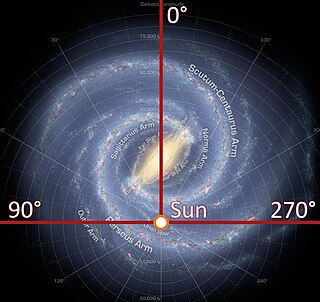 W
WA galactic quadrant, or quadrant of the Galaxy, is one of four circular sectors in the division of the Milky Way Galaxy.
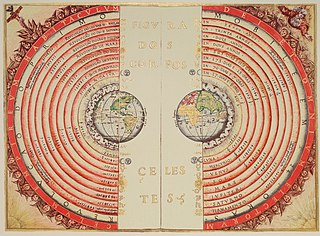 W
WIn astronomy, the geocentric model is a superseded description of the Universe with Earth at the center. Under the geocentric model, the Sun, Moon, stars, and planets all orbit Earth. The geocentric model was the predominant description of the cosmos in many ancient civilizations, such as those of Aristotle in Classical Greece and Ptolemy in Roman Egypt.
 W
WThe horizon is the apparent line that separates the surface of a celestial body from its sky when viewed from the perspective of an observer on or near the surface of the relevant body. This line divides all viewing directions based on whether it intersects the relevant body's surface or not.
 W
WThe horizontal coordinate system is a celestial coordinate system that uses the observer's local horizon as the fundamental plane. It is often used to specify a location in the sky using angles called elevation and azimuth. However, in general a location can include range or can be specified using any coordinate system, such as Cartesian coordinate system.
 W
WIn astronomy and celestial navigation, the hour angle is one of the coordinates used in the equatorial coordinate system to give the direction of a point on the celestial sphere. The hour angle of a point is the angle between two planes: one containing Earth's axis and the zenith, and the other containing Earth's axis and the given point.
 W
WIn astronomy, the hour circle, which together with declination and distance determines the location of any celestial object, is the great circle through the object and the two celestial poles. As such, it is a higher concept than the meridian as defined in astronomy, which takes account of the terrain and depth to the centre of Earth at a ground observer's location. The hour circles, specifically, are perfect circles perpendicular to the celestial equator. By contrast, the declination of an object viewed on the celestial sphere is the angle of that object to/from the celestial equator.
 W
WIn astronomy, the meridian is the great circle passing through the celestial poles, as well as the zenith and nadir of an observer's location. Consequently, it contains also the north and south points on the horizon, and it is perpendicular to the celestial equator and horizon. Meridians, celestial and terrestrial, are determined by the axial-pencil of planes passing through the axis of Earth's rotation. For a location not at a geographical pole there is a unique plane in this axial-pencil through that location. The intersection of this plane with Earth's surface is the geographical meridian, and the intersection of the plane with the celestial sphere is the celestial meridian for that location and time.
 W
WThe nadir is the direction pointing directly below a particular location; that is, it is one of two vertical directions at a specified location, orthogonal to a horizontal flat surface there. Since the concept of being below is itself somewhat vague, scientists define the nadir in more rigorous terms. Specifically, in astronomy, geophysics and related sciences, the nadir at a given point is the local vertical direction pointing in the direction of the force of gravity at that location. The direction opposite of the nadir is the zenith.
 W
WThe northern celestial hemisphere, also called the Northern Sky, is the northern half of the celestial sphere; that is, it lies north of the celestial equator. This arbitrary sphere appears to rotate westward around a polar axis due to Earth's rotation.
 W
WAn orbital pole is either point at the ends of an imaginary line segment that runs through the center of an orbit and is perpendicular to the orbital plane. Projected onto the celestial sphere, orbital poles are similar in concept to celestial poles, but are based on the body's orbit instead of its equator.
 W
WThe north and south celestial poles are the two imaginary points in the sky where the Earth's axis of rotation, indefinitely extended, intersects the celestial sphere. The north and south celestial poles appear permanently directly overhead to observers at the Earth's North Pole and South Pole, respectively. As the Earth spins on its axis, the two celestial poles remain fixed in the sky, and all other celestial points appear to rotate around them, completing one circuit per day.
 W
WIn astronomy, position angle is the convention for measuring angles on the sky. The International Astronomical Union defines it as the angle measured relative to the north celestial pole (NCP), turning positive into the direction of the right ascension. In the standard (non-flipped) images, this is a counterclockwise measure relative to the axis into the direction of positive declination.
 W
WRight ascension is the angular distance of a particular point measured eastward along the celestial equator from the Sun at the March equinox to the point in question above the earth. When paired with declination, these astronomical coordinates specify the location of a point on the celestial sphere in the equatorial coordinate system.
 W
WA rotating frame of reference is a special case of a non-inertial reference frame that is rotating relative to an inertial reference frame. An everyday example of a rotating reference frame is the surface of the Earth.
 W
WThe southern celestial hemisphere, also called the Southern Sky, is the southern half of the celestial sphere; that is, it lies south of the celestial equator. This arbitrary sphere, on which seemingly fixed stars form constellations, appears to rotate westward around a polar axis due to Earth's rotation.
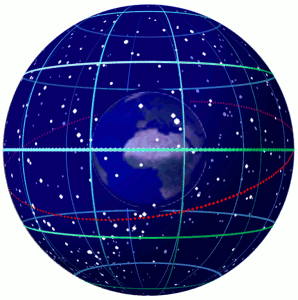 W
WIn astronomy and navigation, the celestial sphere is an abstract sphere that has an arbitrarily large radius and is concentric to Earth. All objects in the sky can be conceived as being projected upon the inner surface of the celestial sphere, which may be centered on Earth or the observer. If centered on the observer, half of the sphere would resemble a hemispherical screen over the observing location.
 W
WThe subsolar point on a planet is the point at which its sun is perceived to be directly overhead ; that is, where the sun's rays strike the planet exactly perpendicular to its surface. It can also mean the point closest to the sun on an astronomical object, even though the sun might not be visible.
 W
WIn the 1950s the astronomer Gérard de Vaucouleurs recognized the existence of a flattened “local supercluster” from the Shapley-Ames Catalog in the environment of the Milky Way. He noticed that when one plots nearby galaxies in 3D, they lie more or less on a plane. A flattened distribution of nebulae had earlier been noted by William Herschel over 200 years. Vera Rubin had also identified the supergalactic plane in the 1950s, but her data remained unpublished. The plane delineated by various galaxies defined in 1976 the equator of the supergalactic coordinate system he developed. In years thereafter with more observation data available de Vaucouleurs findings about the existence of the plane proved right.
 W
WIn astronomy, a vertical circle is a great circle on the celestial sphere that is perpendicular to the horizon. Therefore, it contains the vertical direction, passing through the zenith and the nadir. There is a vertical circle for any given azimuth, where azimuth is the angle measured east from the north on the celestial horizon. The vertical circle which is on the east–west direction is called the prime vertical. The vertical circle which is on the north–south direction is called the local celestial meridian (LCM), or principal vertical. Vertical circles are part of the horizontal coordinate system.Background
 W
WThe zenith is an imaginary point directly "above" a particular location, on the imaginary celestial sphere. "Above" means in the vertical direction opposite to the gravity direction at that location (nadir). The zenith is the "highest" point on the celestial sphere.
 W
WThe zodiac is an area of the sky that extends approximately 8° north or south of the ecliptic, the apparent path of the Sun across the celestial sphere over the course of the year. The paths of the Moon and visible planets are also within the belt of the zodiac.